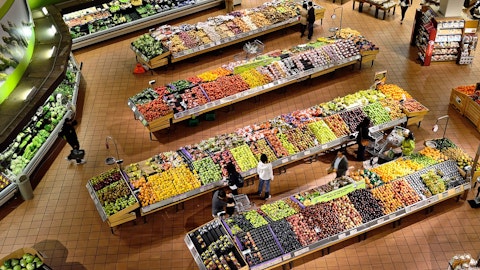And then Argentina, which has been a drag this year would be a bigger contributor next year. So those are where we’re watching the weather. I think when you think about ’24 and the things that create the uncertainty or less visibility in the second half, right with geopolitically, policies, the conflicts that are going on, I mean those are the things that can create dislocations in the crops and in the oil flows. What I will say is I’ve got absolute confidence in our team to execute by staying focused on the things that we could control. Of course, you’ve got the government policies around biofuels and that’s RD and eventually SAF being developed. But the one thing that we’ve seen it definitely appears the regulators want these markets to develop.
And as we show that we’ve got the supply there, I think we’ll — we believe that policies can even be adjusted to ramp up demand. So exactly it’s — the channel is up and to the right. There’ll be some volatility in the supply and demand as those markets sort themselves out, but it is new demand to this industry and it’s firmly in place. And then I touched on the weather, right? We’ve got to watch this El Nino. It should be good for South America. We’re not seeing that right now. And then what it does to river levels in the U.S. when we’re dry and we’ve seen this year, that was another thing that didn’t make the U.S. as competitive on exports with the low river levels, which again hurt export but benefited crushing and then processing. And then China always tough to predict, but a very important customer for beans and corn.
And lastly, on the merchandising piece, it kind of ties in around serving our crushing, serving our third-party customers and then just merch overall in corn, wheat and our freight opportunities. So this dislocation, there can be upside there. A lot of confidence in the team to execute, but it definitely gets a little less clear in the second half.
Ben Bienvenu: Okay. Fair enough. Great. Congratulations on the quarter.
Gregory Heckman: Thank you so much.
Operator: Thank you. The next question comes from Manav Gupta with UBS. Please go ahead.
Manav Gupta: Good morning guys. I wanted to ask you — I understand you’re still negotiating your way through the Viterra deal. But have you had a chance to speak with the bigger shareholders and present a proposition where they could become long-time shareholders of Bunge so they can hold on to the stock even once the lock-in period is over?
Gregory Heckman: Yes. Let me start, John. You can finish. Look, I think one of the things that we were really excited about the Viterra deal and what’s great is they’ve got two great shareholders that really know this business in Glencore, in the Canadian pension funds in CPP and BCI. So they wanted equity. In fact, they wanted more equity than we ultimately gave them and they want the ability to buy more equity for the long-term because they believe in the power of the combination. They believe in the industry, on the important essential role the industry plays and they want to be able to add on to that investment. So that is all laid out in the agreement. They are going to have two board seats each, so they’ll have four of our 12 board seats will be from our new shareholders.
So we’re really excited to be able to get not only the teams together and the asset bases together, once we are able to close this transaction. But we’re excited to bring those new Board members in and bring that experience and that knowledge to help drive this business. So just excited about really all aspects of the combination.
Manav Gupta: Perfect. My quick follow-up here is I wanted to understand a little better what you see as a demand for refined versus unrefined soybean oil. And the reason I’m asking this question is, some of these new units are coming up with PTUs, A, the PTUs are not up to the mark, they’re struggling. And B, what we have heard from some of the producers is that the PTU would be more for tallow and some of the other very hard-to-process feedstocks. They may not be running unrefined soybean oil through it. So just trying to understand that even with the PTUs, is there a possibility that we continue to be see some demand growth on the refined soybean oil side.
John Neppl: Yes. This is John. I think we have anticipated over the long run that RD producers would shift ultimately to crude soybean oil away from refined, but it has been slower than expected. And I think that it’s really more right now about there is new — as the new RD production comes on, it may have pretreatment capability, but the existing units haven’t necessarily transitioned. So the demand we have today for refined as we expect to be fairly steady for a while, even if there’s growth as the new production comes on and has pretreatment. But certainly, we’ve heard some similar things and we believe we can be a great solution either way, whether it’s refined or crude soybean oil. And also, as we’ve said before, we think we have a place in the supply chain around low CI feedstocks as well, and we’ll be — continue to work on that, so that we can provide our energy customers with everything they need.
Gregory Heckman: Yes. And I’d just add one thing. You said that, that margin, right, it will move around between our value chain. You may see some of that move from refined back into the crush with the demand for crude oil. And then I would just also say you hit on an important part that yes, it does take some time to get these units up running and get the catalyst dialed in. And what we hear from some of the folks as they handle some of these other oils that are more difficult, part of that is using the refined oil for a dilution. So we play a role long-term even as they bring in other feedstocks.
Manav Gupta: Thank you.
Operator: Thank you. The next question is from Ben Theurer with Barclays. Please go ahead.
Benjamin Theurer: Good morning, Greg, John. Congrats on the results.
Gregory Heckman: Thank you.
John Neppl: Thank you, Ben.
Benjamin Theurer: Good morning. So just quickly following up on that acquisition you announced in Brazil, CJ Selecta. Is there any more detail you can provide, i.e., like how much you’re going to pay for that so that we can kind of factor that in within our capital allocation assumptions for next year? Make sure you disclose that number?
John Neppl: Yes, it’s about $600 million, Ben.
Benjamin Theurer: Okay. Perfect. So obviously, in light of that, and thanks for that clarification and putting it into context from a CapEx perspective. So you said $1 billion to $1.2 billion, maybe a bit more next year, we get the $600 million that gets us maybe too close to $2 billion, add on a little bit of buyback. So if we think about the cash flow generation and your dividend policy, which in the past, you’ve tried to increase that. How should we think about that going forward? Just given the cash outlay you’re going to have for that CJ Selecta acquisition plus CapEx plus the buybacks. Fair to assume the dividend might not be on the growth side next year?



